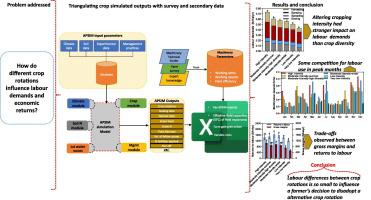Agricultural Systems ( IF 6.6 ) Pub Date : 2022-09-27 , DOI: 10.1016/j.agsy.2022.103516 Julius H. Kotir , Lindsay W. Bell , John A. Kirkegaard , Jeremy Whish , Kojo Atta Aikins

|
CONTEXT
Understanding the quantity and timing of labour to fulfill the goals of different cropping systems or crop rotations is critical, but poorly quantified and understood in many agricultural systems, including the grain-growing regions of eastern Australia. Yet, labour supply and demands are important considerations for farmers and can significantly influence their agronomic management and decisions to adopt modified crop rotation systems.
OBJECTIVE
Here, we investigated the extent to which crop rotation systems, that differed in their intensity (i.e. the proportion of time when crops were growing), and diversity (i.e. the range of crops grown) influence labour requirements and labour productivity.
METHODS
We used the Agricultural Production Systems sIMulator (APSIM) to simulate a set of different crop rotations and combined the output with farmer survey data and expert knowledge derived from farm advisers to compute the labour inputs for key crop operations (i.e. sowing, spraying, harvesting). This information was used to calculate the labour required and the timing of this demand for each cropping system.
RESULTS AND CONCLUSIONS
We showed that as the cropping intensity increases the labour demand also increases, and vice versa. However, only small differences in labour demands were identified between systems with differing crop diversity (i.e. range of crops grown). Thus, when it comes to labour demands, crop diversity is less critical than cropping intensity. Labour demand was highly seasonal, with peaks around the intense operations of sowing and harvesting. These peak demands constrained the area that could be managed by a unit of labour, particularly as the cropping intensity increased. Further, this analysis highlights that the most profitable systems may not necessarily be the most efficient in terms of labour productivity (i.e. return per unit of labour). This analysis shows that when labour is limiting, labour demands and especially peak periods may contribute to a farmer's choice of cropping systems, adding to other critical factors like risk aversion and profit maximisation.
SIGNIFICANCE
The analysis contributes to the literature on the role of labour in the context of influencing the implementation and adoption of what are seemingly more productive or profitable farming systems. In particular, the results demonstrate how labour as a critical farm resource (i.e. its quantity, seasonality and timing, and productivity) can influence the design of crop rotations.
中文翻译:

劳动力需求——影响澳大利亚东部替代种植系统执行和采用的被遗忘的投入
语境
了解实现不同种植系统或轮作目标的劳动力数量和时间至关重要,但在许多农业系统(包括澳大利亚东部的谷物种植区)中,量化和理解不足。然而,劳动力供应和需求是农民的重要考虑因素,可以显着影响他们的农艺管理和采用改良轮作系统的决定。
客观的
在这里,我们调查了不同强度(即作物生长时间比例)和多样性(即作物种植范围)不同的轮作系统对劳动力需求和劳动生产率的影响程度。
方法
我们使用农业生产系统模拟器 (APSIM) 来模拟一组不同的作物轮作,并将输出与农民调查数据和来自农场顾问的专业知识相结合,以计算关键作物操作(即播种、喷洒、收获)的劳动力投入. 该信息用于计算每个种植系统所需的劳动力和这种需求的时间。
结果和结论
我们发现,随着种植强度的增加,劳动力需求也会增加,反之亦然。然而,在具有不同作物多样性的系统之间仅发现了劳动力需求的微小差异(即种植的作物范围)。因此,在劳动力需求方面,作物多样性不如种植强度那么重要。劳动力需求具有很强的季节性,在密集的播种和收割作业期间达到高峰。这些高峰需求限制了一个劳动力单位可以管理的面积,特别是随着种植强度的增加。此外,该分析强调,最有利可图的系统在劳动生产率(即每单位劳动的回报)方面不一定是最有效的。该分析表明,当劳动力受到限制时,劳动力需求,尤其是高峰期可能会影响农民对种植系统的选择,从而增加其他关键因素,如风险规避和利润最大化。
意义
该分析有助于研究劳动力在影响实施和采用看似更具生产力或盈利能力的农业系统方面的作用。特别是,结果表明劳动力作为一种重要的农业资源(即其数量、季节性和时间以及生产力)如何影响轮作的设计。


























 京公网安备 11010802027423号
京公网安备 11010802027423号